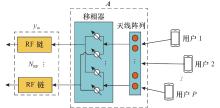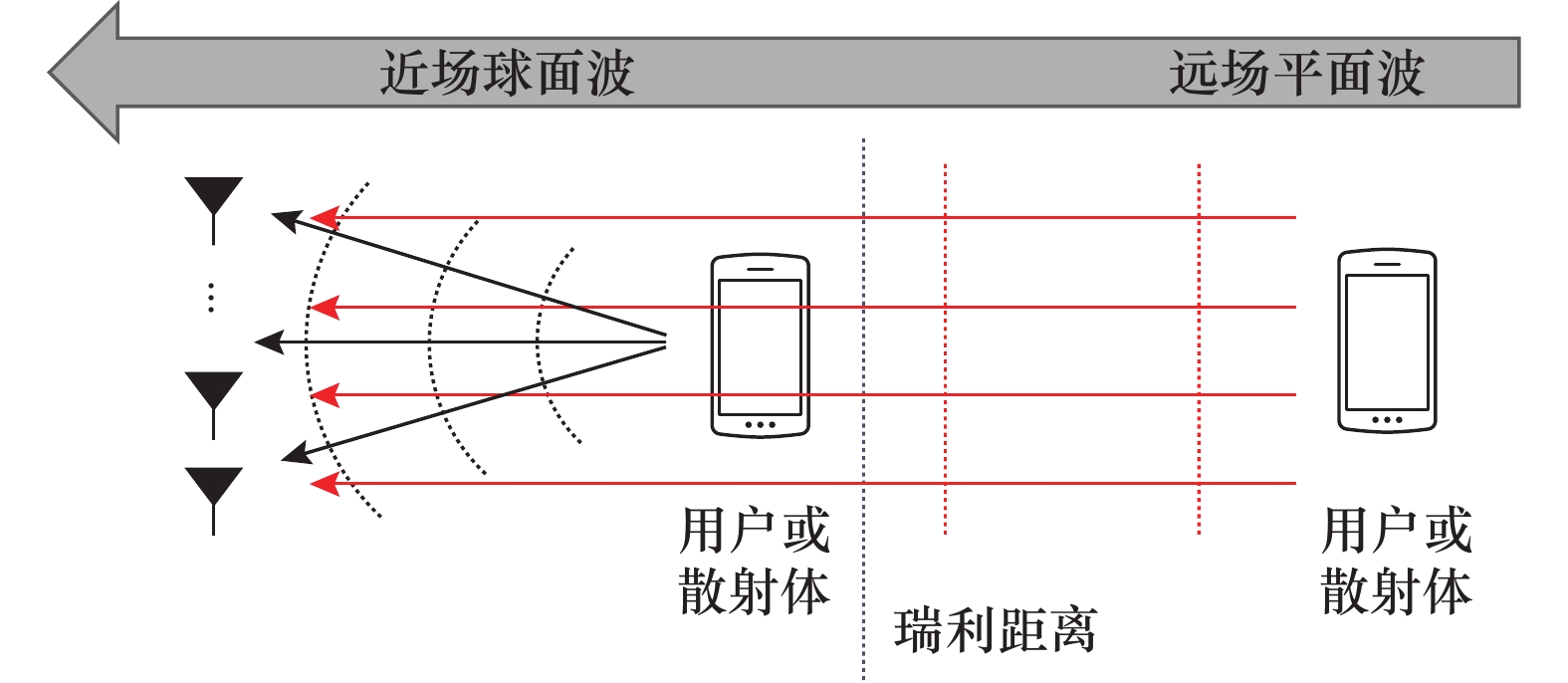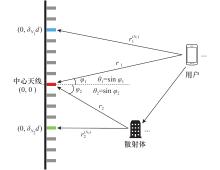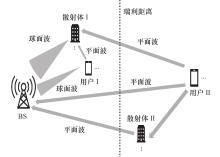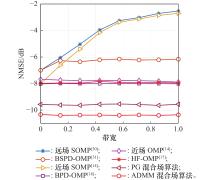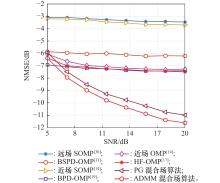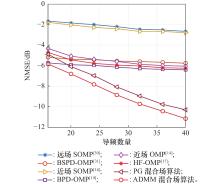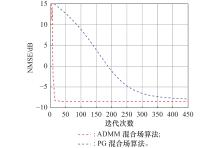Systems Engineering and Electronics ›› 2025, Vol. 47 ›› Issue (8): 2744-2752.doi: 10.12305/j.issn.1001-506X.2025.08.32
• Communications and Networks • Previous Articles Next Articles
Terahertz extremely large-scale MIMO hybrid field channel estimation
Bo GAO1,2( ), Youhua FU1,2,*, Chen LIU1,2
), Youhua FU1,2,*, Chen LIU1,2
- 1. College of Electronic and Optical Engineering and College of Flexible Electronics (Future Technology),Nanjing University of Posts and Telecommunications,Nanjing 210023,China
2. National and Local Joint Engineering Laboratory of RF Integration and Micro-Assembly Technology,Nanjing University of Posts and Telecommunications,Nanjing 210023,China
-
Received:2024-06-12Online:2025-08-31Published:2025-09-04 -
Contact:Youhua FU E-mail:gb191230@163.com
CLC Number:
Cite this article
Bo GAO, Youhua FU, Chen LIU. Terahertz extremely large-scale MIMO hybrid field channel estimation[J]. Systems Engineering and Electronics, 2025, 47(8): 2744-2752.
share this article
| 1 | KAMBLE P, SHAIKH A. 6G wireless networks: vision, requirements, applications and challenges[C]// Proc. of the 5th International Conference on Advances in Science and Technology, 2022: 577−581. |
| 2 | SUYAMA S, OKUYAMA T, NONAKA N, et al. Recent studies on massive MIMO technologies for 5G evolution and 6G[C]// Proc. of the IEEE Radio and Wireless Symposium, 2022: 90−93. |
| 3 | VU D N, DAO N N, WON D, et al. Potential enabling technologies for 6G mobile communication networks: a recent review[C]// Proc. of the 14th International Conference on Ubiquitous and Future Networks, 2023: 631−635. |
| 4 |
LIU Z, ZHANG J Y, WANG Z, et al. Cell-free XL-MIMO meets multi-agent reinforcement learning: architectures, challenges, and future directions[J]. IEEE Wireless Communications, 2024, 31 (4): 155- 162.
doi: 10.1109/MWC.007.2300176 |
| 5 |
GAO X Y, DAI L L, HAN S F, et al. Energy-efficient hybrid analog and digital precoding for mmWave MIMO systems with large antenna arrays[J]. IEEE Journal on Selected Areas in Communications, 2016, 34 (4): 998- 1009.
doi: 10.1109/JSAC.2016.2549418 |
| 6 |
GAO Y, HU H Q, CHEN B, et al. Hybrid precoding for mitigating the beam squint in wideband mmWave MIMO system[J]. IEEE Wireless Communications Letters, 2024, 13 (3): 602- 606.
doi: 10.1109/LWC.2023.3336736 |
| 7 |
ZHAO J H, WU Y, ZHANG Q M, et al. Two-stage channel estimation for mmWave massive MIMO systems based on ResNet-UNet[J]. IEEE Systems Journal, 2023, 17 (3): 4291- 4300.
doi: 10.1109/JSYST.2023.3234048 |
| 8 | SERGHIOU D, KHALILY M, TAFAZOLLI R, et al. Terahertz channel propagation phenomena, measurement techniques and modeling for 6G wireless communication applications: a survey, open challenges and future research directions[J]. IEEE Communications Surveys & Tutorials, 2022, 24 (4): 1957- 1996. |
| 9 | HAN C, WANG Y Q, LI Y B, et al. Terahertz wireless channels: a holistic survey on measurement, modeling, and analysis[J]. IEEE Communications Surveys & Tutorials, 2022, 24 (3): 1670- 1707. |
| 10 |
TARBOUSH S, HADI S, CHEN H, et al. TeraMIMO: a channel simulator for wideband ultra-massive MIMO terahertz communications[J]. IEEE Trans. on Vehicular Technology, 2021, 70 (12): 12325- 12341.
doi: 10.1109/TVT.2021.3123131 |
| 11 | NING B Y, LI L X, CHEN W R, et al. Wideband terahertz communications with AoSA: beam split aggregation and multiplexing[C]// Proc. of the GLOBECOM IEEE Global Communications Conference, 2022: 1709−1714. |
| 12 | CUI M Y, WU Z D, LU Y, et al. Near-field MIMO communications for 6G: fundamentals, challenges, potentials, and future directions[J]. IEEE Communications Magazine, 2023, 61 (1): 40- 46. |
| 13 | TANG S C, DONG Z C, ZHOU W, et al. Beam splitting sensing for terahertz near-field channel estimation[C]// Proc. of the 3rd International Conference on Intelligent Communications and Computing, 2023: 141−146. |
| 14 |
CUI M Y, DAI L L. Channel estimation for extremely large-scale MIMO: far-field or near-field?[J]. IEEE Trans. on Communications, 2022, 70 (4): 2663- 2677.
doi: 10.1109/TCOMM.2022.3146400 |
| 15 |
ZHANG X Y, WANG Z, ZHANG H Y, et al. Near-field channel estimation for extremely large-scale array communications: a model-based deep learning approach[J]. IEEE Communications Letters, 2023, 27 (4): 1155- 1159.
doi: 10.1109/LCOMM.2023.3245084 |
| 16 | CAO J L, DU J H, HAN M, et al. Efficient sparse Bayesian channel estimation for near-field ultra-scale massive MIMO systems[J]. IEEE Wireless Communications Letters, 2023, 12 (12): 2133- 2137. |
| 17 |
WEI X H, DAI L L. Channel estimation for extremely large-scale massive MIMO: far-field, near-field, or hybrid-field[J]. IEEE Communications Letters, 2022, 26 (1): 177- 181.
doi: 10.1109/LCOMM.2021.3124927 |
| 18 | GOU J T, SHAN S, LI Y. Enhancement of spatial-wideband channel estimation based on beam split pattern detection[C]// Proc. of the IEEE 98th Vehicular Technology Conference, 2023. |
| 19 | CUI M Y, DAI L L. Near-field wideband channel estimation for extremely large-scale MIMO[J]. Science China Information Sciences, 2023, 66 (7): 172- 303. |
| 20 | LEE J, GIL G T, LEE Y H. Channel estimation via orthogonal matching pursuit for hybrid MIMO systems in millimeter wave communications[J]. IEEE Trans. on Communications, 2016, 64 (6): 2370- 2386. |
| 21 |
RODRIGUEZ-FERNANDEZ J, GONZALEZ-PRELCIC N, VENUGOPAL K, et al. Frequency-domain compressive channel estimation for frequency-selective hybrid millimeter wave MIMO systems[J]. IEEE Trans. on Wireless Communications, 2018, 17 (5): 2946- 2960.
doi: 10.1109/TWC.2018.2804943 |
| 22 |
DONOHO D L. Compressed sensing[J]. IEEE Trans. on Information Theory, 2006, 52 (4): 1289- 1306.
doi: 10.1109/TIT.2006.871582 |
| 23 |
SHARIFI E, FEGHHI M M, AZARNIA G, et al. Channel estimation based on compressed sensing for massive MIMO systems with lens antenna array[J]. IEEE Access, 2023, 11, 79016- 79032.
doi: 10.1109/ACCESS.2023.3297884 |
| 24 | MUTHUKRISHNAN R, ROHINI R. LASSO: a feature selection technique in predictive modeling for machine learning[C]// Proc. of the IEEE International Conference on Advances in Computer Applications, 2016: 18−20. |
| 25 | JAVANMARDI M, YAZDI M, SHIRAZI M M, et al. Fast and robust L0-tracker using compressive sensing[C]// Proc. of the 2nd International Conference on Pattern Recognition and Image Analysis, 2015. |
| 26 | 刘浩洋, 户将, 李勇锋, 等. 最优化: 建模、算法与理论[M]. 北京: 高教出版社, 2020: 379−413. |
| LIU H Y, HU J, LI Y F, et al. Optimization: modeling, algorithm and theory [M]. Beijing: Higher Education Press, 2020: 379−413. | |
| 27 |
BECK A, TEBOULLE M. A fast iterative shrinkage-thresholding algorithm for linear inverse problems[J]. SIAM Journal of Imaging Sciences, 2009, 2 (1): 183- 202.
doi: 10.1137/080716542 |
| 28 | ABHISHEK S, ESWAR K L, HARSHITH G Y, et al. Study of Lasso and ridge regression using ADMM[C]// Proc. of the 2nd International Conference on Intelligent Technologies, 2022. |
| 29 | CHIBA N, IMAKURA A, HASHIMOTO K. Fast ADMM ℓ1 minimization by applying SMW formula and multi-row simultaneous estimation for light transport matrix acquisition[C]// Proc. of the IEEE International Conference on Robotics and Biomimetics, 2019: 14−21. |
| 30 |
ANJINAPPA C K, GUVENC I. Off-grid aware channel and covariance estimation in mmWave networks[J]. IEEE Trans. on Communications, 2020, 68 (6): 3908- 3921.
doi: 10.1109/TCOMM.2020.2980829 |
| 31 |
TAN J B, DAI L L. Wideband channel estimation for THz massive MIMO[J]. China Communications, 2021, 18 (5): 66- 80.
doi: 10.23919/JCC.2021.05.005 |
| [1] | Mingxiu MO, Lei YUAN, Yan LEI, Huahua YUAN. Impact of imperfect hardware implementation on downlink NOMA short packet communication [J]. Systems Engineering and Electronics, 2025, 47(1): 296-306. |
| [2] | Yongqi SHAO, Lihua YANG, Ao CHANG, Lulu REN. Time-varying channel estimation in RIS-assisted OFDM system [J]. Systems Engineering and Electronics, 2025, 47(1): 324-331. |
| [3] | Gang TAN, Shefeng YAN, Zihao YE, Jirui YANG. Iterative impulsive noise mitigation and channel estimation method for OFDM system [J]. Systems Engineering and Electronics, 2024, 46(8): 2841-2849. |
| [4] | Gang LIU, Yuhang LI, Qingxin YANG, Yi GUO. Channel estimation on intelligent reflecting surface based on compressed sensing [J]. Systems Engineering and Electronics, 2024, 46(7): 2490-2497. |
| [5] | Lihua YANG, Lulu REN, Bo HU, Yongqi SHAO, Qian NIE. Meta-learning based time-varying channel estimation method [J]. Systems Engineering and Electronics, 2023, 45(6): 1872-1879. |
| [6] | Ce JI, Boyan TIAN, Rong GENG, Boqun LI. FBMC/OQAM system channel estimation based on VSCBOMP algorithm [J]. Systems Engineering and Electronics, 2023, 45(4): 1193-1199. |
| [7] | Xiaofei LU, Shuojing JIN, Ling HONG, Fengzhou DAI. Target micro-Doppler analysis of TVAR model based on clustering [J]. Systems Engineering and Electronics, 2023, 45(3): 660-668. |
| [8] | Ce JI, Bohan SONG, Rong GENG, Minjun LIANG. Deep learning based channel estimation for OFDM systems in fast time-varying channel [J]. Systems Engineering and Electronics, 2023, 45(11): 3649-3655. |
| [9] | Ning LI, Bing HUO, Ruiliang SONG, Zhi REN. Efficient reporting approach of edge nodes' information in multi-PAN terahertz wireless personal area network [J]. Systems Engineering and Electronics, 2022, 44(5): 1709-1716. |
| [10] | Jian DANG, Yewei LI, Yongdong ZHU, Rongbin GUO, Zaichen ZHANG, Liang WU. Progressive channel estimation method for RIS-assisted communication system [J]. Systems Engineering and Electronics, 2022, 44(3): 998-1006. |
| [11] | Hao WU, Ying KANG, Songhu GE, Yaxing LI, Jin MENG. Interference rejection combining method in receive chain of VHF/UHF communication radio [J]. Systems Engineering and Electronics, 2022, 44(3): 1014-1021. |
| [12] | Buhua LIU, Dan DING, Liu YANG, Naiyang XUE, Zhongqian LIU. OFDM data transmission technology of UAV based on deep neural network [J]. Systems Engineering and Electronics, 2022, 44(2): 696-702. |
| [13] | Tao JIN, Di ZHU, Jieying HE, Wenyu WANG. Study on the characteristics of high terahertz band atmospheric background radiation observed from satellites [J]. Systems Engineering and Electronics, 2022, 44(10): 3003-3011. |
| [14] | Yonglei QI, Xihong CHEN, Dizhe YUAN. Joint channel estimation and equalization algorithm based on UW for SC-FDE system [J]. Systems Engineering and Electronics, 2022, 44(10): 3258-3265. |
| [15] | Ziyan LIU, Shanshan MA, Jing LIANG, Mingcheng ZHU, Lei YUAN. Attention mechanism based CNN channel estimation algorithm in millimeter-wave massive MIMO system [J]. Systems Engineering and Electronics, 2022, 44(1): 307-312. |
| Viewed | ||||||
|
Full text |
|
|||||
|
Abstract |
|
|||||
